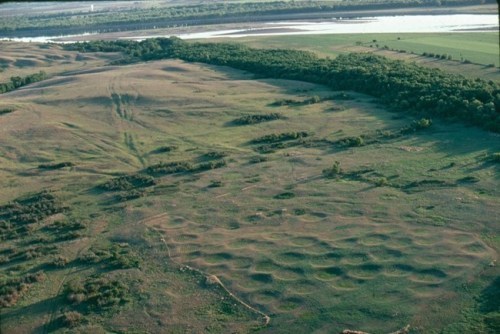Last updated: September 22, 2023
Article
Hidatsa Women & Earthlodges of the Upper Missouri River
In traditional Hidatsa society, women constructed, owned, and maintained the earthlodge, or awadi. The women gathered building material during the year, when the snow that covered the Northern Plains made it easier to transport heavy loads. Together, women of a clan constructed the earthlodge, supervised by an older woman who possessed sacred and practical knowledge of earthlodge construction.

NPS Photo
They began by placing four cottonwood posts, strengthened with a circular framework of logs, willow branches, dried grass, and sod. The elaborate structure could be built in just 6-10 days and was home to between ten and twenty people, often sisters and their families with several generations. There were over 100 earthlodges in Big Hidatsa Village, which was established around 1600 and abandoned in 1845.
Today, shallow depressions remain in the ground to mark the sites of these earthlodges, assisting the imagination in envisioning the layout, size, and development of these former communities.
The earthlodge at Knife River Indian Villages National Historic Site is a powerful interpretive tool for visitors, and a garden and drying racks are reminders of the agricultural practices developed by Hidatsa, Mandan, and Arikara on the Northern Plains.
Aspects of the matriarchal order, clan systems, and connection to the landscape persist in contemporary Hidatsa society. The voices of Hidatsa women today are vital to understanding the history of the landscape.
Learn more and plan your visit
-
Video: Earthlodge Tour (and other videos) Ranger Darian provides a tour of the inside of Knife River Indian Villages reconstructed earthlodge.
-
Video: The People (Mandan/Hidatsa flute player and storyteller Keith Bear uses music and story to bring to life the culture of the Upper Missouri)
- Duration:
- 5 minutes, 5 seconds
Mandan/Hidatsa flute player and storyteller Keith Bear uses music and story to bring to life the culture of the Upper Missouri.
Tags
- knife river indian villages national historic site
- lewis & clark national historic trail
- cultural landscape
- indigenous heritage
- hidatsa
- mandan
- arikara
- earthlodge
- sacagawea
- lewis and clark
- knife river
- archeology
- village
- native american culture
- lewis and clark expedition
- lewis and clark national historic trail
- north dakota
- knife river indian villages national historic site
- mwr
- women in history
- women's history
- featured article
- women and the environment
- engaging with the environment
- archaeology
- native american
- women

